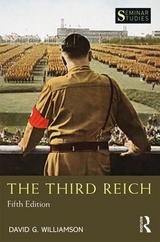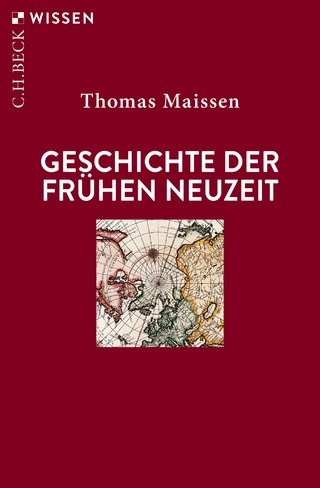
The Third Reich
Longman (Verlag)
978-1-4082-2319-2 (ISBN)
- Titel erscheint in neuer Auflage
- Artikel merken
introduce readers to the historiography of the Third Reich
analyse the reasons for Hitler's rise to power
look at how the Nazi regime consolidated it's grip on power during the period March 1933- August 1934
explain how Nazi Germany was governed and discuss to what extent Hitler can be viewed as a 'weak dictator'
analyse Hitler's economic, foreign and social policies in both war and peace up to 1945, as well as the development of Nazi racial and eugenic policies.
The analysis of these themes is backed up with an increased selection of documents, which enable students to discuss the key issues more fully. Providing a concise but comprehensive account of the origins, course and downfall of the Third Reich, this new edition of an already classic text will be an invaluable introduction to the subject for students.
Head of History and Politics, Highgate School, London
CONTENTS
Introduction to the Series
Acknowledgements
Chronology
Who’s Who
Glossary
Maps
PART ONE: INTRODUCTION
1. THE HISTORICAL DEBATE
Can the Third Reich be ‘Historicised’?
PART TWO: ANALYSIS
2. THE ORIGINS AND RISE OF NATIONAL SOCIALISM
The Ideological Roots
The Bismarckian Reich: An Incubator of National Socialism?
The German Revolution, 1918–19: A Turning Point that did not Turn?
Adolf Hitler and the Formation of the NSDAP, 1919–24
The Renaissance of the Nazi Party, 1925–30
Nazi Voters, 1930–32
The Road to Power, September 1930–January 1933
3. THE LEGAL REVOLUTION AND THE CONSOLIDATION OF POWER, 1933–34
The Dissolution of the Reichstag and the Election of 5 March 1933
The ‘Revolution from Below’ and the Enabling Act
The Process of Gleichschaltung
The Churches
The Defeat of the Second Revolution
4. STATE, PARTY AND FÜHRER: THE GOVERNMENT OF NAZI GERMANY, 1933–39
Ministries and ‘Supreme Reich Authorities’, 1933–38
Himmler and the SS State
The Centralisation of the Reich
The Civil Service
The Party
The Role of Hitler
5. THE ECONOMY, 1933–39
Work Creation and Economic Recovery, 1933–35
Agriculture
The Mittelstand
Schacht and the Financing of German Rearmament
The Four Year Plan
Industrialists and the Four Year Plan: winners and losers
Rearmament and the German Economy, 1936–39
6. THE PEOPLE’S COMMUNITY: GERMAN SOCIETY AND THE THIRD REICH, 1933–39
The Work of the Reich Ministry of Popular Enlightenment and Propaganda
Education and Youth
The Peasantry
Women and the Family
p; Nazi Health and Eugenic Policies
The ‘Asocials’ and Homosexuals
Gypsies, Part-Africans and the Slav Minorities
The Jews
The Germans and the Jews
8. FOREIGN POLICY, 1933–39
Hitler’s Priorities, 1933–37
The Anschluss
The Destruction of Czechoslovakia
The Polish Crisis and the Outbreak of War
9. GERMANY, EUROPE AND THE WORLD, 1939–45
The British Problem, 1940–41
The Decision to Attack Soviet Russia
From European to World War, 1941–45
Europe under German Occupation, 1939–44
‘Ethnic Cleansing’ and Settlement Policies in Eastern Europe
The Holocaust
10. THE HOME FRONT, 1939–45
Disintegration of the Führer State
The Increasing Power of the Political Party and the SS
The War Economy
Food Supplies and Rationing
Solving the Labour Crisis in the War Industries
The Impact of War on the German People, 1942–45
The End of the Hitler Regime
Postscript to the Third Reich: The Doenitz Government
11. THE GERMAN OPPOSITION
Resistance and Resistenz
Opposition from the Churches
Opposition on the Left
The Challenge of Youth Culture
Resistance by the Military and Conservative Elites
The Road to 20 July 1944
Why was there no German Revolution in 1945?
PART THREE: ASSESSMENT
12. THE THIRD REICH IN RETROSPECT
Hitler’s Rise to Power
The Nazi regime
How 'modern'as the Third Reich
The Legacy of Nazi Germany
PART FOUR: DOCUMENTS nbsp; Guide to Further Reading
References
Index
| Erscheint lt. Verlag | 24.2.2011 |
|---|---|
| Reihe/Serie | Seminar Studies In History |
| Verlagsort | Harlow |
| Sprache | englisch |
| Maße | 241 x 173 mm |
| Gewicht | 468 g |
| Themenwelt | Geschichte ► Allgemeine Geschichte ► Neuzeit (bis 1918) |
| Geschichte ► Allgemeine Geschichte ► 1918 bis 1945 | |
| Geisteswissenschaften ► Geschichte ► Regional- / Ländergeschichte | |
| ISBN-10 | 1-4082-2319-8 / 1408223198 |
| ISBN-13 | 978-1-4082-2319-2 / 9781408223192 |
| Zustand | Neuware |
| Haben Sie eine Frage zum Produkt? |
aus dem Bereich



